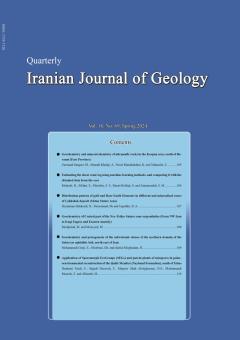Estimating the shear sonic log using machine learning methods, and comparing it with the obtained data from the core
Subject Areas :
Houshang Mehrabi
1
![]() ,
Ebrahim Sfidari
2
,
Seyedeh Sepideh Mirrabie
3
,
Sadegh Barati Boldaji
4
,
Seyed Mohammad Zamanzadeh
5
,
Ebrahim Sfidari
2
,
Seyedeh Sepideh Mirrabie
3
,
Sadegh Barati Boldaji
4
,
Seyed Mohammad Zamanzadeh
5
1 -
2 - 2. Assistant Professor, Petroleum Geology Group, Research Institute of Applied Science, Academic Center for Education, Culture and Research, Tehran, Iran
3 - 3. Graduated Master of Science, School of Geology, College of Science, University of Tehran, Tehran, Iran
4 - 1. Master of Science, Petroleum Geology Group, Research Institute of Applied Science, Academic Center for Education, Culture and Research, Tehran, Iran
5 - University of Tehran
Keywords: Python, Estimation, Shear Sonic Log, Machine Learning,
Abstract :
Machine learning methods are widely used today to estimate petrophysical data. In this study, an attempt has been made to calculate shear sonic log (DTS) from other petrophysical data using machine learning methods and compare it with the sonic data obtained from the core. For this purpose, computational methods such as Standard Deviation, Isolation Forest, Min. Covariance, and Outlier Factors were used to normalize the data and were compared. Given the amount of missing data and box plots, the Standard Deviation method was selected for normalization. The machine learning methods used include Random Forest, Multiple Regression, Boosted Regression, Support Vector Regression, K-Nearest Neighbor, and MLP Regressor. Multiple regression had the lowest evaluation index (R2=0.94), while Random Forest regression had the highest correlation between the estimated shear sonic log and the original shear sonic log with an evaluation index of 0.98. Therefore, Random Forest regression was used for the final estimation, and to prevent data generalization or overfitting, the GridSearchCV function was used to calculate optimal hyperparameters and final estimation. The estimated sonic log showed a very high similarity with the core data.
Akhundi, H., Ghafoori, M. and Lashkaripour, G.R., 2014. Prediction of shear wave velocity using artificial neural network technique, multiple regression and petrophysical data: A case study in Asmari reservoir (SW Iran). Open Journal of Geology, 4, 303-313. Doi: https://10.4236/ojg.2014.47023
Anemangely, M., Ramezanzadeh, A. and Behboud, M.M., 2019. Geomechanical parameter estimation from mechanical specific energy using artificial intelligence. Journal of Petroleum Science and Engineering, 175, 407-429. Doi: https://doi.org/10.1016/j.petrol.2018.12.054
Breiman, L., 2001. Random forests. Machine learning, 45(1), 5-32. Doi: https://doi.org/10.1023/A:1010933404324
Eskandari, H., Rezaee, M.R. and Mohammadnia, M., 2004. Application of multiple regression and artificial neural network techniques to predict shear wave velocity from wireline log data for a carbonate reservoir South-West Iran. CSEG recorder, 42, 40-48.
Fjaer, E., Holt, R.M., Horsrud, P. and Raaen, A.M., 2008. Petroleum Related Rock Mechanics. Elsevier Science Publisher: Amsterdam, The Netherlands.
Forkuor, G., Hounkpatin, O.K., Welp, G. and Thiel, M., 2017. High resolution mapping of soil properties using remote sensing variables in south-western Burkina Faso: a comparison of machine learning and multiple linear regression models. PloS one, 12(1), p.e0170478. Doi: https://doi.org/10.1371/journal.pone.0170478
Goldberger, A.S., 1962. Best linear unbiased prediction in the generalized linear regression model. Journal of the American Statistical Association, 57(298), 369-375. Doi: https://doi.org/10.1080/01621459.1962.10480665
Heiat, A., 2002. Comparison of artificial neural network and regression models for estimating software development effort. Information and software Technology, 44(15), 911-922. Doi: https://doi.org/10.1016/S0950-5849(02)00128-3
McGregor, A., Hall, M., Lorier, P. and Brunskill, J., 2004. Flow clustering using machine learning techniques. In Passive and Active Network Measurement: 5th International Workshop, PAM 2004, Antibes Juan-les-Pins, France, April 19-20, 2004. Proceedings 5, 205-214. Springer Berlin Heidelberg.
Rajabi, M., Bohloli, B. and Ahangar, E.G., 2010. Intelligent approaches for prediction of compressional, shear and Stoneley wave velocities from conventional well log data: A case study from the Sarvak carbonate reservoir in the Abadan Plain (Southwestern Iran). Computers & Geosciences, 36(5), 647-664. Doi: https://doi.org/10.1016/j.cageo.2009.09.008
Ramcharitar, K. and Hosein, R., 2016, June. Rock Mechanical Properties of Shallow Unconsolidated Sandstone Formations. Paper presented at the SPE Trinidad and Tobago Section Energy Resources Conference, Port of Spain, Trinidad and Tobago. Doi: https://doi.org/10.2118/180803-MS
Hosseini, Z., Gharechelou, S., Mahboubi, A., Moussavi-Harami, R., Kadkhodaie-Ilkhchi, A., and Zeinali, M., 2021, Shear wave velocity estimation utilizing statistical and multi-intelligent models from petrophysical data in a mixed carbonate-siliciclastic reservoir, SW Iran. Iranian Journal of Oil and Gas Science and Technology, 10(1), 15-39. doi: https://10.22050/ijogst.2020.241095.1556
Steinwart, I. and Christmann, A., 2008. Support vector machines. Springer Science and Business Media.
Tariq, Z., Elkatatny, S.M., Mahmoud, M.A., Abdulraheem, A., Abdelwahab, A.Z. and Woldeamanuel, M., 2017, June. Estimation of Rock Mechanical Parameters Using Artificial Intelligence Tools. In ARMA US Rock Mechanics/Geomechanics Symposium (ARMA-2017). ARMA.
Tixier, M.P., Loveless, G.W. and Anderson, R.A., 1975. Estimation of formation strength from the mechanical-properties log (incudes associated paper 6400). Journal of Petroleum Technology, 27(03), 283-293. Doi: https://doi.org/10.2118/4532-PA
Xu, Y., Zhang, H. and Guan, Z., 2021. Dynamic characteristics of downhole bit load and analysis of conversion efficiency of drill string vibration energy. Energies, 14(1), 229. Doi: https://doi.org/10.3390/en14010229
Zou, X., 2019. Application of machine learning in shear wave prediction of jiaoshiba shale gas horizontal well. Jianghan Petroleum Science and Technology, 29(4), 16-22.
Kuzmanovski, I. and Aleksovska, S., 2003. Optimization of artificial neural networks for prediction of the unit cell parameters in orthorhombic perovskites. Comparison with multiple linear regression. Chemometrics and Intelligent Laboratory Systems, 67(2), pp.167-174.
